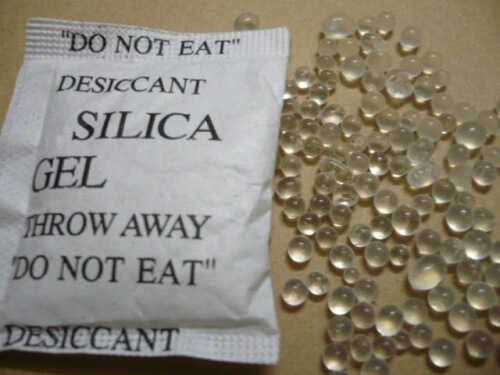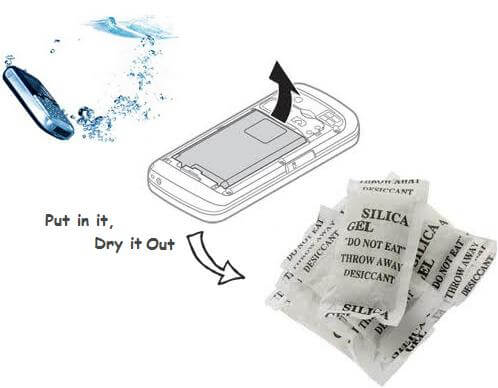Eleven Uses for Silica Gel Packets


Written and verified by the psychologist Raquel Aldana
Even if you don’t recognize it by its name, silica gel is one of those products that’s practically everywhere. You can often find it in small paper shopping bags or in shoe boxes, for example. There are many other uses for silica gel, though, and in this article we’ll explain them to you.
You’ve probably seen the little packets before, but didn’t know what they’re there for, and you’ve just thrown them away. Silica gel is the granular and porous form of silicon dioxide, manufactured from sodium silicate, a water and glass compound.The purpose of these little packets is to help eliminate excess moisture from forming when you store something for a long time. Because of these packets’ porous nature, they help ensure that your products arrive in perfect condition when they otherwise may have been damaged.
However, manufacturers recommend that you take them out of the product once it arrives, because the packets are very fragile and can break open easily.
A little history on silica gel…
Silica gel has been around since 1640, and is well known in the scientific community. People used it in a variety of ways in the past, it was a chemistry professor, Walter A. Patrick, who patented it in 1919.
This product was used in the cruel gas chambers of World War II, absorbing the escaped gases and vapors. Interestingly, also in World War II silica gel people used it to keep penicillin stores dry and in good condition. For that reason, it has helped to save many lives.
What are some other uses for silica gel?
Silica gel is a drying agent that is useful in many other ways around the house. The gel by itself isn’t toxic, but there are sometimes certain other compounds in it to enhance its effects, such as cobalt chloride, which can be harmful to your health.
Read more: 7 Toxic Items in Your Home
The granules that you receive in those packets usually have a transparent or whitish color, which turns blue or pink when wet. The bag will indicate whether the gel packet is toxic or not. But let’s look at some of the alternative uses for this product:
 Drying flowers
Drying flowers
Imagine you have a perfect flower that you want to keep, either because it’s sentimental or beautiful. You can keep it in that condition forever by covering it in silica gel. Make sure that you cover it completely, and then wait for two to three days until it dries out (never more than five days).
Keep your silver shiny
As you know, silver tends to tarnish in humidity. Avoid this by storing a bag of silica gel inside your silver box.
To protect your old photographs
Old paper photographs can deteriorate over the years. You can avoid this by storing them with a packet of silica gel.
Prevent wet clothes from smelling
When you go to the pool, beach, or gym you might end up putting wet clothing inside your backpack or bag, causing a bad smell. To avoid this, just put some silica gel packets in your bag.
Please read: Tricks for Odorless and Absorbent Towels
To preserve metal parts
Moisture causes metal to oxidize and rust, destroying tools and instruments. Put one of these silica packets in your tool box and stop this from happening.
Storing seeds
Seeds can rot when exposed to prolonged moisture. This, however, can be avoided if you store them with silica gel.
Dry out your cellphone

Sometimes your electronic appliances can get wet. In those instances, you might have heard about the typical method of putting them in a bag of rice to dry out. However, with this method they are also exposed to rice dust, which can be harmful for it. Silica gel beads perform the same function by absorbing any moisture that has affected your devices.
Other uses for silica gel
- To prevent condensation form forming inside the car, store a silica gel packet under the seat.
- Cat litter contains silica, which makes it so absorbent.
- You can use silica packets to keep food in perfect condition, as long as you’re sure it’s not toxic. You should never eat silica gel!
- Silica can protect cameras and lenses from water damage.
These and many other reasons are why you should hang onto these packets and reuse them!
All cited sources were thoroughly reviewed by our team to ensure their quality, reliability, currency, and validity. The bibliography of this article was considered reliable and of academic or scientific accuracy.
- Ruthruff, R. F., Booth, H. S., & Dolance, A. (2007). Silica Gel. In Inorganic Syntheses. https://onlinelibrary.wiley.com/doi/abs/10.1002/9780470132333.ch26
- Gurav, J. L., Jung, I. K., Park, H. H., Kang, E. S., & Nadargi, D. Y. (2010). Silica aerogel: Synthesis and applications. Journal of Nanomaterials. https://www.hindawi.com/journals/jnm/2010/409310/
- Silvera, A. J. B., & Juvinao, J. (2004). Comportamiento del gel de sílice como filtro deshumidificador en sistemas de acondicionamiento de aire por compresión de vapor. Revista Facultad de Ingeniería Universidad de Antioquia, (31), 73-83. https://www.redalyc.org/pdf/430/43003106.pdf
This text is provided for informational purposes only and does not replace consultation with a professional. If in doubt, consult your specialist.








